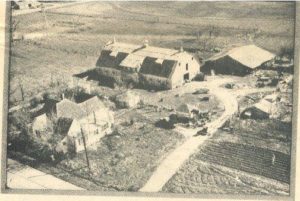
Aerial view of the farm owned by the Greens. The Red Roof Barn is the largest building. The inset to the roof was where Green broadcast his radio show. This was something in the late 1920s. (Complement of John W. Dub Duncan.)
Sometime in the 1880s a farmer from Illinois came to Hunt County to visit his daughter and her family, also farmers. Riding in a wagon to the couple’s farmhouse, the Illinois farmer observed different methods of farming between the two states. Yes, Illinois does not have the same climate Texas does, but the differences he noticed were relevant to technology in either state.
First he noticed how muddy the streams were. Then he looked at the fields of cotton, all plowed and planted in rows. That was where the soil came from that muddied the water. For miles and miles all that was visible were fields of cotton. His daughter’s family had a milk cow, a garden spot thriving with vegetables and a few hogs. No orchard was in sight only cotton.
During his visit the Illinois farmer talked to several old-timers. He learned that when the county was young, streams were so clear the bottom could be seen filled with fish. Most of the farms raised their own food plus wheat and oats for sale. Cattle roamed on the open, virgin prairies. However, the arrival of the railroads in 1880 changed the agricultural scene.
Cotton was a cash crop, buyers in Greenville and other surrounding towns paid “good money” for the farmers’ crops. Buyers and landowners pushed for larger fields and less livestock. The more cotton produced the lower the prices were. But no one wanted to quit such a profitable business.
The Illinois farmer probably talked with his son-in-law about rotating crops and plowing in large circles to prevent runoff from rain. He was not the only one in the area trying to introduce new farm methods.
Last week I wrote about J. Riley Green of Wolfe City and the introduction of better roads. Green (1869-1927) was also an advocate of better farming techniques, diversification of crops and raising livestock as well as cotton. He served as public weigher for the north part of Hunt County and saw the amounts of cotton produced.
Around the time of World War I J. Riley Green began a successful career as an auctioneer of livestock and agricultural real estate. At one point in 1918 he sold a herd of cattle, mules, and horses in Celeste and netted $6,000. Today that equates to $99,551.52 according to Inflation Calculator at westegg.com.
Green was a great after dinner speaker at many banquets held by farmers groups. He talked about growing wheat one year, corn the next and cotton the third year. He talked about leaving a field fallow or planting peanuts to increase nutrients lost when growing cotton. He encouraged raising hogs or poultry in place of beef cattle. Every family should have a milk cow, he preached.
In 1921 J. Riley Green and his wife were instrumental in forming the Hunt County Stockmen Association where he held an office. At that time Mr. and Mrs. Green built an enormous red barn on their farm south of Wolfe City. He was so successful as an agricultural speaker he started the Red Roof Barn radio program.
At the same time the Greens started a herd of Jersey cattle. These small dairy cattle were first raised on the Island of Jersey in the English Channel. They are known for high butterfat content, lower maintenance costs, and a genial disposition.
At the time of his death, J. Riley Green was a member of the Board of Directors of the National Jersey Cattle Raisers Association of American. His wife continued to be active in the association and in raising Jersey cattle. And the red barn? It remained a landmark in Wolfe City until a few years ago when it was razed to make way for the new Wolfe City High School. I suspect it is missed.
